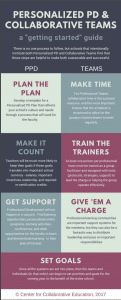Personalized PD and Collaborative Teams: A Symbiotic Approach to Professional Learning, Part 2
CompetencyWorks Blog
This post originally appeared at the Center for Collaborative Education on September 7, 2017. In Part 1 of this series, Lebeaux shared some analysis of the ways in which Personalized Professional Development and Collaborative Teams mutually benefit one another and support a school’s process of sustainable, positive transformation. In Part 2, below, she provides some guidance on potential approaches to bringing both of these into practice.
Bringing about transformative teacher practice is challenging in any circumstance; in a low-performing school falling under local and state scrutiny, it’s particularly dire. And yet schools fraught with high pressure for students to “perform” well and for data to demonstrate their turnaround most particularly require the kind of motivated, self-improving, and engaged staff that these tandem PD structures would provide. As a result, we require a strategic and intentional approach to implementing these two practices, each of which is revolutionary in their own right, to make them feasible and accessible to the schools that need them the most.
Although the two structures mutually reinforce each other, they need not be introduced simultaneously. The two columns of tips in the infographic seen here are not chronological steps in a process so much as attributes important to the success of each. As a result, we can explore the earliest steps of each approach individually below.

Getting Started with Personalized Professional Development
There are many manifestations of personalized professional development. Some states and school districts are experimenting with the use of teacher microcredentials, which are digital badges (or a series of them) that educators can earn by demonstrating attainment of certain skills, outcomes or competencies. Others encourage teacher choice by providing a flexible menu of professional development modules or experiences from which teachers can choose, or “pathways” different staff members can pursue. Still others provide individualized coaching to all faculty members to help them work on personal goals.
However, one structure seems universally beneficial in the implementation of personalized professional development: a learning plan. At CCE, we have recently established a Personalized Professional Learning Plan (PPLP), which help our participants set goals that align with their own assets and challenges as well as the needs of their respective schools – and then organize a slate of PD experiences that support progress toward these goals. The aim is for teachers to set goals – ideally along with a supervisor or coach – and to build learning experiences that support progress toward them. This central feature is present in most personalizing professional development, and it’s an easy place to start for a school hoping to move along the continuum toward greater teacher agency.
Getting Started with Collaborative Professional Learning
At CCE, we typically refer to structured, shared, collaborative time among teams of teachers as Professional Learning Communities, or PLCs, and we have worked to support schools in many localities in developing strong PLC culture. We tend to recommend the establishment of regular shared planning time by school administrators and introduce participants to formal norm-setting and a variety of discussion protocols. However, we have also coached more ad hoc design teams and leadership teams that might typically use more informal structures, and many of these same “getting started” recommendations apply.
The first charge of a school leader ready to institute PLCs or other collaborative groups must be to allocate an appropriate period of time on a regular basis for staff members to use for this purpose. This time should be no less than 45 minutes to allow for adequate transitions and deep dives into texts, dilemmas, and works in progress. Next, the school leader must designate or encourage at least one person from each group to learn facilitation skills. Finally, although the leader must be willing to “give up the reins” and allow teams to set their own agendas, the leader will find greater success if s/he provides the group with a general charge – improving student performance in literacy, say, or planning for some aspect of the school’s redesign. This kind of focus serves as a catalyst for more general growth with many positive repercussions on the various participants and the school at large.
Pulling it Together
In the end, there is no single formula for successful implementation of collaborative teams or personalized PD, just as there is no single formula for school transformation. However, when school leaders and educators come together to build a set of structures and practices that make congruent the growth of the individual and the growth of the whole, they are setting the stage for exciting, transformative learning – and setting a fantastic example for their students.
See also:
- Personalized PD and Collaborative Teams: A Symbiotic Approach to Professional Learning, Part 1
- Building Field Readiness & Capacity to Personalize
- Training Teachers for Competency-Based Learning Classrooms
Diana Lebeaux (Senior Associate, Personalized Learning Network) works at CCE to develop dynamic professional development, coach and support schools through the school change and design process, and grow a robust and successful Personalized Learning Network.